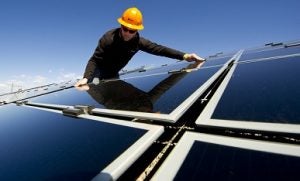Trump Promises a Renaissance for Coal – But These Clean Energy Numbers Tell a Different Story
A big part of President Trump’s agenda involves rolling back critical environmental protections. And yet, the issue that most people think won him the 2016 election is the economy.
 From coast to coast – and especially places in between – jobs were the most pressing concern for American voters. So Trump has promised he will create 25 million new ones over the next decade by, among other things, reviving America’s declining coal industry.
From coast to coast – and especially places in between – jobs were the most pressing concern for American voters. So Trump has promised he will create 25 million new ones over the next decade by, among other things, reviving America’s declining coal industry.
“We’re gonna put the miners back to work,” he told a roaring crowd in West Virginia last year.
But for all the bluster about bringing coal production back to life, Trump is not just ignoring market realities – he’s also overlooking the biggest economic opportunity since the computer revolution.
Here are the good energy jobs
In total, 2.7 million people [PDF] now work in clean energy nationwide, manufacturing and installing solar panels, auditing energy efficiency, developing smart energy apps, building windmills and on and on.
The remarkable growth of the solar and wind industries is already well-documented: Today, nearly 102,000 Americans work in wind and more than 260,000 in solar. Together, that’s more than three times the number of people who work in coal.
[Tweet “Trump promises a renaissance for coal – but these clean energy numbers tell a different story”]
Less known, but equally important, is the rapidly emerging energy efficiency sector – now employing 2.2 million – as well as the advanced vehicle industry, which today employs 174,000 people. All this points to a changing energy economy.
And yet, on the campaign trail and since he was sworn in, Trump has consistently favored coal over clean energy, claiming that excessive regulation is what’s been holding back coal.
The real story behind coal’s trouble
Boosting coal jobs by eliminating the most basic pollution protections may be a popular talking point in some places, but that plan is not supported by reality.
The truth is, coal has had a hard time competing on price for many years now. The American natural gas boom with its lower prices, along with a constant price drop for renewable energy sources such as wind and solar, have put significant pressure on coal.
The president is hitching his economic wagon to a dying star.
Result: American coal has been in decline for decades, and nothing the Trump administration can say or do will reverse that long-term trend. The president is hitching his economic wagon to a dying star – and ironically, he’s likely to encourage even more natural gas production, which will add price pressure on coal.
So what does all this mean?
Time for Trump to come clean
Eventually, the president is going to have to explain to unemployed coal miners in West Virginia, Kentucky and Pennsylvania – who are suffering real economic pain – why he didn’t put them back to work. Or why he didn’t help them get retrained for jobs that will carry them through the next 30 years.
Community colleges, chambers of commerce and small businesses nationwide are chomping at the bit to retrain workers to make, install and maintain our 21st century energy system. Federal support for that approach would deliver far more jobs than empty rhetoric about reviving coal.
In other words, if he truly wants to get struggling coal workers back in business, Trump should look to the industry of the future, rather than the past. His voters will reward him if he does.
The post originally appeared on our EDF Voices blog.










